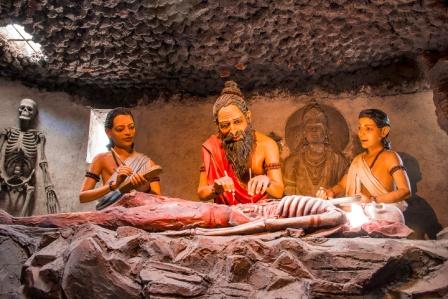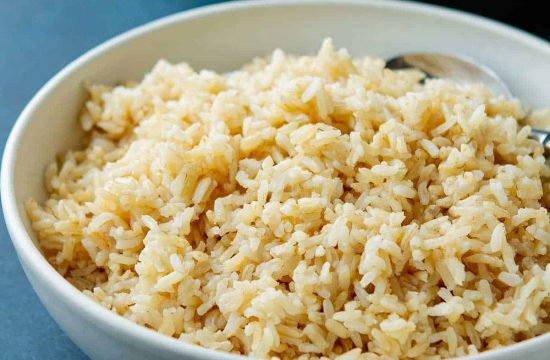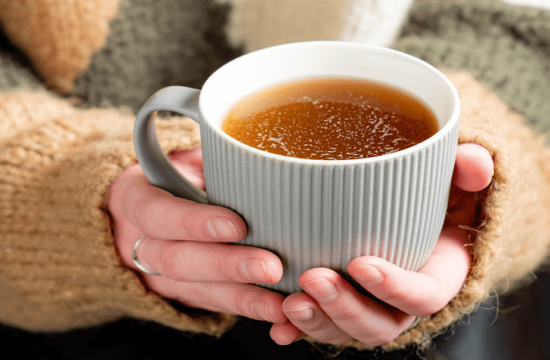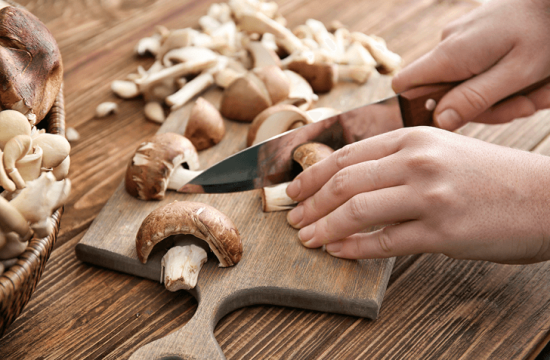This article explains Sushruta Samhita Sutrasthana Chapter 40 “Dravya Rasa Guna Virya Vipaka Vijnaniya Adhyaya” – Knowledge of substances and their qualities.


Dravya rasaguna Virya Vipaka Vijnaniya Adhyaya – knowledge of substances and their qualities
अथातो द्रव्यरसगुणवीर्यविपाकविज्ञानीयमध्यायं व्याख्यास्यामः ||१||
यथोवाच भगवान् धन्वन्तरिः ||२||
We will now expound the chapter by name Dravya rasa guna Virya Vipaka Vijnaniya – Knowledge of Substances, their tastes, qualities, potencies and tastes after- digestion; as revealed by the venerable Dhanvantari.
Read – Lord Dhanwantari ‘The God of Ayurveda’
Dravyam Pradhanam
Substances are the most important
केचिदाचार्या ब्रुवते- द्रव्यं प्रधानं, कस्मात्? व्यवस्थितत्वात्, इह खलु द्रव्यं व्यवस्थितं न रसादयः, यथा आमे फले ये रसादयस्ते पक्वे न सन्ति; नित्यत्वाच्च, नित्यं हि द्रव्यमनित्या गुणाः, यथा कल्कादिप्रविभागः, स एव सम्पन्नरसगन्धो व्यापन्नरसगन्धो वा भवति; स्वजात्यवस्थानाच्च, यथा हि पार्थिवं द्रव्यमन्यभावं न गच्छत्येवं शेषाणि; पञ्चेन्द्रियग्रहणाश्च, पञ्चभिरिन्द्रियैर्गृह्यते द्रव्यं न रसादयः; आश्रयत्वाच्च, द्रव्यमाश्रिता रसादयः; आरम्भसामर्थ्याच्च, द्रव्याश्रित आरम्भः, यथा- ‘विदारिगन्धादिमाहृत्य सङ्क्षुद्य विपचेत्’ इत्येवमादिषु न रसादिष्वारम्भः; शास्त्रप्रामाण्याच्च, शास्त्रे हि द्रव्यं प्रधानमुपदेशे योगानां, यथा- ‘मातुलुङ्गाग्निमन्थौ च’ इत्यादौ न रसादय उपदिश्यन्ते; क्रमापेक्षितत्वाच्च रसादीनां, रसादयो हि द्रव्यक्रममपेक्षन्ते, यथा- तरुणे तरुणाः सम्पूर्णे सम्पूर्णा इति; एकदेशसाध्यत्वाच्च, द्रव्याणामेकदेशेनापि व्याधयः साध्यन्ते, यथा- महावृक्षक्षीरेणेति; तस्माद्द्रव्यं प्रधानं, न रसादयः, कस्मात्? निरवयवत्वात् |
द्रव्यलक्षणं तु ‘क्रियागुणवत् समवायिकारणम्’ इति ||३||
Some authorities – say – that Dravya (substance / drug in the present context) is the most important, why so? Because of the following reasons,
1. Vyavasthitatva – (constancy) according to this science, Dravya (substances) is constant but not the tastes (qualities) etc. for eg, the tastes etc. present in the unripe fruit are not present in the ripe fruit.
2. Nityatva (permanency) – Dravya (substance) is permanent and Guna (qualities) are not permanent; for eg: qualities of preparations such as paste etc. (juice, powder, infusion, decoction etc) will be either good or bad due to time, mode of preparing etc.
3. Svajatyavasthana – (stability in its own category) just as a substance of Parthiva category does not change into that of a different category; in the same way the remaining also (apya, aganeya, vayaviya and nabhasa substance do not undergo change into any category other than its own by any means).
4. Panchendriya graham – (perceptible by the five sense organs) Dravya (substances) only is perceptible by all the five sense organs but not the tastes etc.
5. Ashrayatva (seat / asylum) – taste etc. (qualities) dwell or reside in the substance itself.
6. Arambha Samarthya – (ability to start work-commencement of work / treatment in this context) depend upon substances (drugs) only. As in the statement – ‘Vidarigandhadi should be collected, pounded and boiled in water and such others (statements)”, it is clear that collection, pounding, boiling etc works can be initiated and done only with the dravya but they cannot be accomplished in its qualities like taste etc.
7. Shastra Pramana – (testified by scriptures) authoritative texts have advocated the substances as the most important and not the taste etc. In the description of any formulation, it is only the dravyas which have been mentioned but not its taste etc. Example – In the formulation ‘Matulungadi Yoga’ the drugs included in it i.e., Matulunga, Agnimantha etc are mentioned and they are the names of the substances (dravya). On the other hand, their tastes etc qualities have not been mentioned in these contexts.
8. Kramapekshitatva – (succeeding order) tastes etc, desire the order of succession (in respect of time); for eg, in the young (unripe, immature substance / drug) tastes etc. are also young (mild / weak) and in the fully grown (mature / ripe) drug, these (taste etc.) are also full grown (strong, well manifest).
9. Ekadesha sadhyatva – (efficacious even by parts) – diseases can be treated even by any one part / portion of the substances / drugs). For example, the milky sap of Mahavriksha (snuhi) is used for curing many diseases like abdominal tumors, colic, distension (flatulence) of abdomen, enlargement of liver etc. The same is not possible by parts of taste etc.
By these reasons, Dravya (substance/ drug) is the most important and not so the tastes etc (qualities); because these (tastes etc) have no parts and the definition of Dravya (substance) is “that having functions and qualities as its inherent (inseparable) cause” Functions and qualities are considered as Avayava (component) of the substances.
Read – Dravya: Meaning, Ayurvedic Explanation
Rasa pradhanam
Taste is the most important
नेत्याहुरन्ये, रसास्तु प्रधानं; कस्मात्? आगमात्, आगमो हि शास्त्रमुच्यते; शास्त्रे हि रसा अधिकृताः, यथा- रसायत्त आहार इति, तस्मिंस्तु प्राणाः; उपदेशाच्च, उपदिश्यन्ते हि रसाः, यथा- मधुराम्ललवणा वातं शमयन्ति; अनुमानाच्च, रसेन ह्यनुमीयते द्रव्यं, यथा- मधुरमिति; ऋषिवचनाच्च, ऋषिवचनं वेदो यथा- किञ्चिदिज्यार्थं मधुरमाहरेदिति, तस्माद्रसाः प्रधानं; रसेषु गुणसञ्ज्ञा |
रसलक्षणमन्यत्रोपदेक्ष्यामः ||४||
Some other authorities say – it is not so, it is rasa (tastes of substances) only that is most important. Why? Because (of the following reason).
1. Agama – (authority) Agama are called science and (treatises of science). Science deals with tastes only; as it is said “food depends on tastes and life depends on food”
2. Upadesha – (instructions / implications) tastes only are implied in statements such as “sweet, sour and salt tastes mitigate Vata”.
3. Anumana – (inference) the substance / drug is determined by its taste, such as the sweet one (sour, bitter etc).
4. Rishi Vachana – (words of sages) sayings of sages are the Vedas; as in the Vedic statement; “bring some sweet for conducting the sacrifice.”
Because of these reasons, Rasa (taste) is the most important. Through the rasa (taste), Guna (qualities of substances) is understood. The properties of tastes will be described elsewhere.
Read – Six Tastes Of Ayurveda: Qualities, Benefits, Therapeutic Action (Shad Rasa)
Viryam Pradhanam
Potency is the most important
नेत्याहुरन्ये, वीर्यं प्रधानमिति |
कस्मात्? तद्वशेनौषधकर्मनिष्पत्तेः |
इहौषधकर्माण्यूर्ध्वाधोभागोभयभागसंशोधनसंशमनसङ्ग्राहिकाग्निदीपनपीडनलेखनबृंहण- रसायनवाजीकरणश्वयथुकरविलयनदहनदारणमादनप्राणघ्नविषप्रशमनादीनि वीर्यप्राधान्याद्भवन्ति |
तच्च वीर्यं द्विविधमुष्णं शीतं च, अग्नीषोमीयत्वाज्जगतः |
केचिदष्टविधमाहुः- शीतमुष्णं स्निग्धं रूक्षं विशदं पिच्छिलं मृदु तीक्ष्णं चेति |
एतानि वीर्याणि स्वबलगुणोत्कर्षाद्रसमभिभूयात्मकर्म कुर्वन्ति |
यथा तावन्महत्पञ्चमूलं कषायं तिक्तानुरसं वातं शमयति, उष्णवीर्यत्वात्; तथा कुलत्थः कषायः, कटुकः पलाण्डुः, स्नेहभावाच्च; मधुरश्चेक्षुरसो वातं वर्धयति, शीतवीर्यत्वात्; कटुका पिप्पली पित्तं शमयति, मृदुशीतवीर्यत्वात्; अम्लमामलकं लवणं सैन्धवं च; तिक्ता काकमाची पित्तं वर्धयति, उष्णवीर्यत्वात्, मधुरा मत्स्याश्च; कटुकं मूलकं श्लेष्माणं वर्धयति, स्निग्धवीर्यत्वात्; अम्लं कपित्थं श्लेष्माणां शमयति, रूक्षवीर्यत्वात्, मधुरं क्षौद्रं च; तदेतन्निदर्शनमात्रमुक्तम् ||५||
Some other authorities say, it is not so, Virya (Potency of the drug) is the most important; because it is by these only actions of the drugs are made possible i.e., virya is responsible for the actions of the drugs. According to this science, actions such as purifications of the body by upper route; lower route and by both together, mitigation, withholding, elimination of doshas, increase of digestive power, squeezing, scarifying, stoutening, rejuvenation, vilification, producing swelling and reducing it, dissolving, burning,(cauterization), bursting of swelling, causing toxicity, causing loss of life, detoxification of poison etc, become possible because of predominance of virya.
This Virya is of two kinds – Ushna (hot) and Sheeta (cold) because the world is predominant in qualities of fire and water. Some others say that virya is of eight kinds – viz,
- sheeta (cold),
- ushna (hot),
- snigdha (unctuous),
- ruksha (dry),
- vishada (viscid),
- picchila (slimy),
- mridu (soft), and
- tikshna (sharp, penetrating)
These potencies becoming powerful in their own qualities and nullifying the Rasa (tastes of the drug) perform their actions. For example,
- Maha Panchamula is astringent in its primary taste and bitter in its secondary taste, still it mitigates vata because of hot potency, so also kulattha which is astringent;
- Palandu which is pungent mitigates vata because of its unctuousness
- Juice of iksu though sweet in taste still increases vata because of its cold potency
- Pippali though pungent in taste still mitigates pitta, because of its soft and cold potencies
- Similarly, Amalaka though sour and Saidhava though salty in taste, still mitigate pitta;
- Kakamachi though bitter in taste still increases Pitta because of its hot potency;
- Similarly, Matsya (fish) though sweet (increases pitta)
- Mulaka though pungent still mitigates Kapha because of its unctuous potency;
- Kapitha though sour in taste mitigates kapha because of dry potency,
- Madhu i.e., honey, is sweet in taste mitigates kapha due to its dry potency,
These are mentioned here for the sake of examples only.
Read – Veerya, Potency Of Herbs And Doshas – Inter-relationship
भवन्ति चात्र-
ये रसा वातशमना भवन्ति यदि तेषु वै |
रौक्ष्यलाघवशैत्यानि न ते हन्युः समीरणम् ||६||
ये रसाः पित्तशमना भवन्ति यदि तेषु वै |
तैक्ष्ण्यौष्ण्यलघुताश्चैव न ते तत्कर्मकारिणः ||७||
ये रसाः श्लेष्मशमना भवन्ति यदि तेषु वै |
स्नेहगौरवशैत्यानि न ते तत्कर्मकारिणः ||८||
Those tastes which are expected to mitigate vata, if possessing dry, light (soft) and cold potencies, then they (tastes) will not mitigate Vata.
Those tastes which are expected to mitigate Pitta, if possessing sharp, hot and light( soft) potencies, then they will not perform that function (of mitigating pitta).
Those tastes which are expected to mitigate Kapha when possessing unctuous, heavy and cold potencies, then they will not do that function of mitigating Kapha.
तस्माद्वीर्यं प्रधानमिति ||९||
Hence Virya is the most important.
Vipaka Pradhanam
Taste – after- digestion is most important
नेत्याहुरन्ये, विपाकः प्रधानमिति |
कस्मात्? सम्यङ्मिथ्याविपक्वत्वात्; इह सर्वद्रवाण्यभ्यवहृतानि सम्यङ्मिथ्याविपक्वानि गुणं दोषं वा जनयन्ति |
तत्राहुरन्ये- प्रति रसं पाक इति |
केचित्त्रिविधमिच्छन्ति- मधुरमम्लं कटुकं चेति |
तत्तु न सम्यक्, भूतगुणादामाच्चान्योऽम्लो विपाको नास्ति; पित्तं हि विदग्धमम्लतामुपैत्याग्नेयत्वात्; यद्येवं लवणोऽप्यन्यः पाको भविष्यति, श्लेष्मा हि विदग्धो लवणतामुपैतीति |
मधुरो मधुरस्याम्लोऽम्लस्यैवं सर्वेषामिति केचिदाहुः; दृष्टान्तं चोपदिशन्ति- यथा तावत् क्षीरमुखागतं पच्यमानं मधुरमेव स्यात्तथा शालियवमुद्गादयः प्रकीर्णाः स्वभावमुत्तरकालेऽपि न परित्यजन्ति तद्वदिति |
केचिद्वदन्ति- अबलवन्तो बलवतां वशमायान्तीति |
एवमनवस्थितिः, तस्मादसिद्धान्त एषः |
आगमे हि द्विविध एव पाको मधुरः कटुकश्च |
तयोर्मधुराख्यो गुरुः, कटुकाख्यो लघुरिति |
तत्र पृथिव्यप्तेजोवाय्वाकाशानां द्वैविध्यं भवति गुणसाधर्म्याद्गुरुता लघुता च; पृथिव्यापश्च गुर्व्यः, शेषाणि लघूनि; तस्माद्द्विविध एव पाक इति ||१०||
Yet others say; “It is not so, Vipaka (taste after digestion of the drug) is most important”. Why So? Because of proper and improper digestion. All substances ingested produce their good or bad effect only after undergoing proper or improper digestion.
Some authorities says that each rasa (taste) undergoes digestion (and remains as such in Vipika also) i.e., since there are six tastes, there are six kinds of vipaka as well.Yet others says that it (Vipaka) is three only viz, Madhura (sweet), Amla (sour) and Katu (pungent). Both these opinions are not correct.
There is no Amla (sour) Vipaka separately, because from the properties of five primary elements or from the agama i.e. scriptures / texts of Ayurveda (not mentioned in the scriptures), the presence of a separate amla vipaka cannot be justified.
Pitta itself when improperly cooked becomes sour (in taste) because of its hot quality. Similarly, there is no lavana (salty) Vipaka separately. Slesma (kapha) itself when improperly cooked becomes salty (taste).
Still others say that sweet taste becomes sweet itself (after digestion), sour taste becomes sour (itself). Similarly other tastes (remains as such after digestion).They cite example just like milk being cooked (boiled) in a vessel remains sweet only (even after cooking) and rice, barley, green gram etc. which get scattered (or sown) do not leave off their natural (original) qualities even later on.
Some others say that weak ones (tastes) are overpowered by the strong, thus there is uncertainty, hence this postulate is untenable.
Scriptures also declare that Vipaka (taste after digestion) are of two kinds only, viz, Madhura (sweet) and Katuka (pungent). Among these, the sweet one is guru (heavy) and pungent one is laghu (light). Prthvi, Ap, Tejas, Vayu and Akasa (five elements) form two groups viz, Guru (heavy) and Laghu (light) by combination of identical properties. Prthvi and ap are guru (heavy) and the remaining are laghu. Hence Paka (Vipaka) is of two kinds only.
Read – Vipaka: Taste Conversion During And After Digestion
Identifying the manifested Vipaka
भवन्ति चात्र-
द्रव्येषु पच्यमानेषु येष्वम्बुपृथिवीगुणाः |
निर्वर्तन्तेऽधिकास्तत्र पाको मधुर उच्यते ||११||
तेजोऽनिलाकाशगुणाः पच्यमानेषु येषु तु |
निर्वर्तन्तेऽधिकास्तत्र पाकः कटुक उच्यते ||१२||
When the qualities of Prthvi and ambu (ap) are produced more during the digestion of substances, then the ensuring Vipaka is called Madhura (sweet).
When qualities of Tejas, Vayu and Akasa are produced greatly during digestion, then the ensuing Vipaka is called Katu (pungent).
Read – Panchamahabhuta: Application, Areas of Utility in Ayurveda treatment
Combination of dravya etc. factors is important!
पृथक्त्वदर्शिनामेष वादिनां वादसङ्ग्रहः |
चतुर्णामपि सामग्र्यमिच्छन्त्यत्र विपश्चितः ||१३||
These are the collection of postulates of authorities who argue emphasizing the importance of each one (Dravya, rasa, virya and Vipaka) separately. Scholars however consider the combination of all the four factors as important.
तद्द्रव्यमात्मना किञ्चित्किञ्चिद्वीर्येण सेवितम् |
किञ्चिद्रसविपाकाभ्यां दोषं हन्ति करोति वा ||१४||
Some substances either mitigate or aggravate the dosas by their own self (Dravya), some others do so by their virya (potency), some else by their rasa (taste) and yet others by their Vipaka (taste after digestion).
Why is dravya the most important one?
पाको नास्ति विना वीर्याद्वीर्यं नास्ति विना रसात् |
रसो नास्ति विना द्रव्याद्द्रव्यं श्रेष्ठतमं स्मृतम् ||१५||
There can be no Vipaka without Virya, no Virya without rasa and no rasa without Dravya; hence Dravya is the most important of all.
जन्म तु द्रव्यरसयोरन्योन्यापेक्षिकं स्मृतम् |
अन्योन्यापेक्षिकं जन्म यथा स्याद्देहदेहिनोः ||१६||
वीर्यसञ्ज्ञा गुणा येऽष्टौ तेऽपि द्रव्याश्रयाः स्मृताः |
रसेषु न भवन्त्येते निर्गुणास्तु गुणाः स्मृताः ||१७||
द्रव्ये द्रव्याणि यस्माद्धि विपच्यन्ते न षड्रसाः |
श्रेष्ठं द्रव्यमतो ज्ञेयं, शेषा भावास्तदाश्रयाः ||१८||
Dravya and rasa are said to be dependent on one another by their birth (origin) just like the body and soul.
The eight qualities mentioned as Virya also reside in the Dravya itself. These are not present in the Rasas, since the qualities by themselves cannot accommodate other qualities (to reside within them). It is the Dravya itself that undergoes digestion in the body but not the six tastes. Hence Dravya only should be understood as most important and all the remaining factors as sheltered in it (present within the Dravya).
Read – Rasa Panchaka – 5 Qualities Of Substance (Dravya)
Amimamsyam bhesajam
Properties of drugs not to be discussed
अमीमांस्यान्यचिन्त्यानि प्रसिद्धानि स्वभावतः |
आगमेनोपयोज्यानि भेषजानि विचक्षणैः ||१९||
प्रत्यक्षलक्षणफलाः प्रसिद्धाश्च स्वभावतः |
नौषधीर्हेतुभिर्विद्वान् परीक्षेत कदाचन ||२०||
सहस्रेणापि हेतूनां नाम्बष्ठादिर्विरचयेत् |
तस्मात्तिष्ठेत्तु मतिमानागमे न तु हेतुषु ||२१||
Intelligent persons (physicians) should not discuss or think about the properties of drugs which are already popular and well known by their very nature (by birth itself). He should bring them into practice as advocated in the scriptures (texts of Ayurveda).
The drugs whose properties (effects) and results are perceivable directly and those which are popular and well known by their very nature (naturally known since a long time) should never be re-examined by an intelligent physician. Even with a thousand reasons, causes, discussions or arguments the purgation effect of Ambasthadi Gana groups of medicines (herbs, drugs) cannot be proved or justified (because they do not produce purgation and this is popularly known through ages). Therefore, the wise person (physician) should believe / trust (adhere to) the scriptures and not on other causes / reasons.
इति श्रीसुश्रुतसंहितायां सूत्रस्थाने द्रव्यगुणरसवीर्यविपाकविज्ञानीयो नाम चत्वारिंशत्तमोऽध्यायः ॥४०॥
Thus ends the 40th chapter by name Dravya – rasa – Guna – Virya – Vipaka Vijnaniya in Sutra sthana of Sushruta Samhita.












